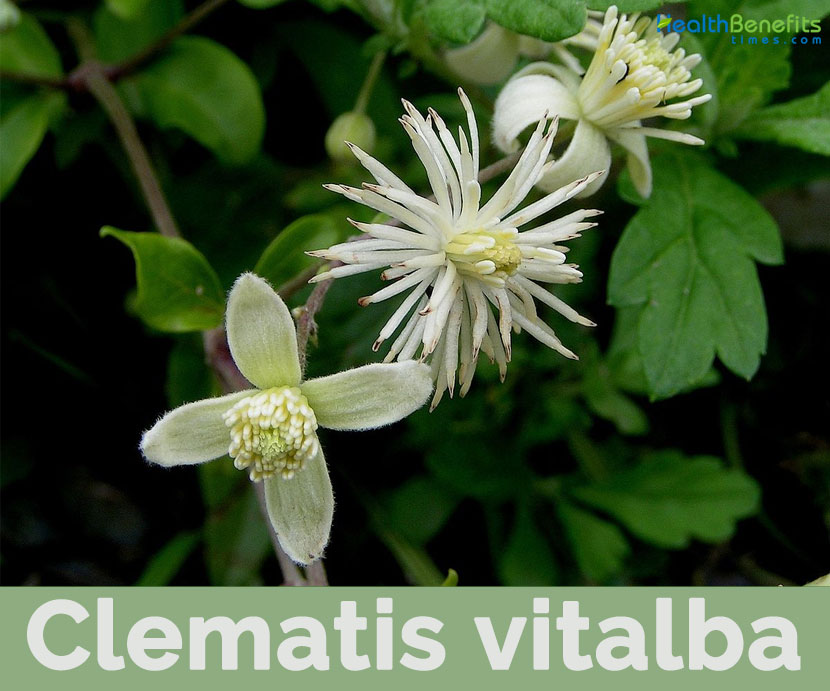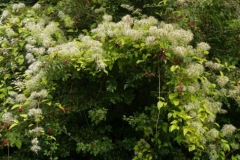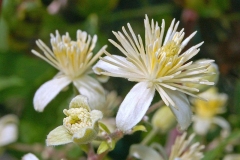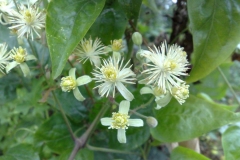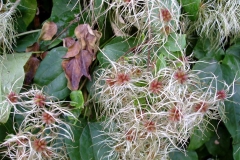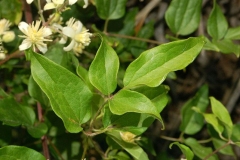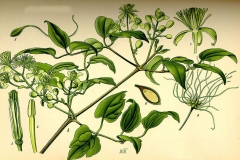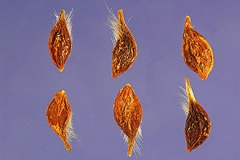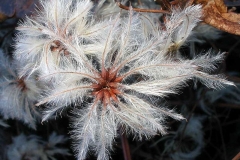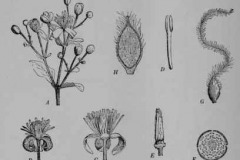The Latin Clematis is thought to derive from the Greek word for shoot as it is a climbing plant. The name vitalba is derived from the Latin words for ‘white vine’, referring to the mass of white flowers that cover vines in summer. The common name, ‘traveller’s joy’, also refers to this massive floral display, whereas the common names ‘old man’s beard’ and ‘virgin’s bower’ refer to the creamy mass of feathery achenes that hang on the bare canes through winter. Other common names are used regionally in England. It was also recommended that traveller’s joy did the devil’s work as it would kill other plants by out-competing them. This is why it is viewed as an intrusive weed by many people. Medicinally, the leaves of the plant mixed with wine would serve to combat various problems diarrhea and suitably combined matrix relieve pain and tooth or even have beneficial effects on snake bites. It was used by beggars to cause ulceration of the skin, thus stimulating the mercy of passers, so the plant was known also as beggars grass.
Clematis vitalba Facts
| Old man's beard Quick Facts | |
|---|---|
| Name: | Old man's beard |
| Scientific Name: | Clematis vitalba |
| Origin | Northern Africa, Europe and western Asia |
| Colors | Initially green turning to dark brown as they mature |
| Shapes | Hairy achenes that are compressed and are 2.0-2.5 mm long. They are ovoid and pubescent |
| Health benefits | Beneficial for syphilis, gout, malaria, dysentery, rheumatism, asthma, insomnia, insect bites, eye infections, toothache, gonorrhea, blisters, ulcers, bone illnesses, dermatological disorders, varicosity and beriberi |
| Name | Old man’s beard |
|---|---|
| Scientific Name | Clematis vitalba |
| Native | Northern Africa (i.e. northern Algeria), Europe (i.e. France, Portugal, Spain, UK, Austria, Belgium, Czechoslovakia, Germany, Hungary, the Netherlands, Poland, Switzerland, southern Russia, Ukraine, Albania, Bulgaria, Greece, Italy, Macedonia, Romania and Yugoslavia) and western Asia (i.e. Afghanistan, Cyprus, northern Iran, Lebanon, Syria, Turkey, Armenia, Azerbaijan and Georgia) |
| Common Names | Traveller’s joy, Old man’s beard, Clematide vitalba, Vezzadro, Vitalba, virgin’s bower, boys-bacca, clematis, evergreen clematis, graybeard, hedge feathers, mile-a-minute, Tom-bacca, whiffy cane, White virgin’s bower, Wild clematis, Fragrant clemati, Evergreen Traveler’s-Joy |
| Name in Other Languages | Abkhazian: Алмышәӡахәа, Амшәӡахәа Albanian: Kulpra, kulpër, kulpëra e egër, kërpnaja Arabic: Zayan alsyaj (ظَيّان السياج) Ṭayyān al siyāj, zian ‘abyad (ظيان أبيض) , maleaa sama (ملعى سامة) Aragonese: Belliguera, Betiguera, Betiquera, Billuertera, Meliguera, Petiquera, Velliguera, Vetiguera, Vetiquera, Villuertera Armenian: Mamrich’ khaghoghaterev (Մամրիչ խաղողատերև) Azerbaijani: Üzümyarpaq ağəsmə Basque: Aihenzuri, aixeneskerra, autina, ayen-bedarra, burukagei, ezkerrayen, metu Bavarian: Lüln Belgium: Bosdruif Bulgarian: obiknoven povet (обикновен повет), obiknoven pavit (обикновен павит), skrebŭr (скребър) Catalan: Clemàtide, Herba de llagues, Vidalba, Vidauba, Ridorta, Vidorta, virumbelles, vedigueres, lligabose, vidalba vera Corsican: Vitalba, Vitalbula, Vittichju Croatian: Pavitina, obična pavitina Czech: Plamének plotní, plamének obecný Danish: Almindelig skovranke, Skovranke Dutch: Bosrank, Wilde bosrank, Duivelsgaren, Heggenwurger, Smookhout, Vuurkruid English: Evergreen clematis, Old man’s beard, Traveler’s joy, Traveller’s joy, White virgin’s bower, Wild clematis, Fragrant clemati, Evergreen Traveler’s-Joy, graybeard Estonian: Harilik elulõng Finnish: Saksankärhö French: Aubavis, Aubervigne, Bois de pipe, Bois à fumer, Clématite blanche, Clématite des haies, Clématite des bois, Clématite vigne blanche, Herbe aux gueux, Cranquillier, Vigne de Salomon, berceau de la vierge, cheveux de la Bonne Dame, clématite blanche, clématite brûlante, herbe aux gueux, vigne blanche, vigne de Salomon Galician: Herba doncela German: Echte Waldrebe, Gemeine Waldrebe, Gewöhnliche Waldrebe, Weisse Waldrebe, Wilder Waldrebe, Weiße Waldrebe, Niele Greek: Kli̱matís i̱ Lef̱kámpelos (Κληματίς η Λευκάμπελος), agrámpeli i lefkámpelos (αγράμπελη η λευκάμπελος) Hindi: Saphēda klēmāṭisa (सफेद क्लेमाटिस) Hungarian: Bércse iszalag, Erdei iszalag, közöseges iszalag Icelandic: Hnoðrabergsóley, Skúfsóley, Þýsk bergsóley Irish: Gabhrán Italian: Clematide vitalba, Vitalba, Viorna, Clematide, vezzadro Japanese : Kuremachisu vitaruba (クレマチス・ ヴィタルバ) Latvian: Vīnlapu mežvītenis Limburgan: Bosraank, Rieraank Lithuanian: Gelsvoji raganė Lombard: Idàsa, Zùta Netherlands: Bosrank Norwegian: Tysk klematis Occitan: Entrevadis, Redòrta, Vidalba Persian: شقايق پيچ , سفید کلماتیس , ﻛﻠﻤﺎﺗﻴﺲ ﺳﻔﻴﺪ Polish : Powojnik pnący Portuguese: Cipó do reino, Clematide-branca, Clematite-branca, Vide branca, Vitalba, clematite Romanian: Curpen-de-pădure Russian: Lomonos vinogradolistnyj (Ломонос виноградолистный ), klematis vinogradolistnyy (клематис виноградолистный) Serbian: Belaya loza (бела лоза), pavit (павит), skrobut (скробут) Slovakian: Plamienok plotný, Plamienok rovný Slovenian: Navadni srobot, Srobot navadni Spanish: Abrazadera, barba de Dios, birgaza borde, botigueras , canduerca, Cabello de angel, clematites Silvestre, Clemátide, enredadera, flor del amor, Hierba de pordioseros, Hierba de los pordioseros, Muermera, Vidarra, Vid blanca, Virgaza, Virigaza, Herba de llagues, Hierba de los pordioseros, Parilla, Sogaza, Vidalba, Vidauba, Vidraria de hojas anchas, hierba de las llagas, Swedish: Skogsklematis Turkish: Adifilbahr , Akasma, Filbahar, Filbahri, Peçek Upper Sorbian: Lěsny pryšćenc Ukrainian: lomynis vynohradolystyy (ломиніс виноградолистий) Vietnamese: Trắng cây ông lão Walloon: Rampioûle ordinaire Welsh: Barf hen ŵr, Barf yr hen wr |
| Plant Growth Habit | Fast-growing, deciduous, woody, broad leaved climbing perennial shrub |
| Growing Climates | Hedgerows, forest margins to hedgerows, fence lines, dunes, riverbanks, grassland, agricultural areas, coastland, natural forests, planted forests, range/grasslands, riparian zones, ruderal/disturbed, scrub/shrublands, urban areas, disturbed lands, wooded areas, tall grasses |
| Soil | Prefers rich and slightly alkaline soils, but can tolerate almost all soil types; from light sandy to heavy clay. For best results, grow the plant in well-draining moist non-acid soil. |
| Plant Size | Over 10 m in length and can reach 15-20 cm in diameter |
| Stem | Stems are dark purple to green colored, deeply ridged, and covered with silky white tiny hair near the apex, when young, but turn grey and stringy with thick nodes upon maturity |
| Leaf | Opposite, and almost all comprise five 3-10 cm leaflets with long petioles. Leaflets are variable in size and shape, ovate, acute to acuminate, rounded or sub-cordate at the base, and coarsely toothed or entire |
| Flowering season | July to September |
| Flower | Flower panicles with up to 20 flowers develop in the leaf axil. Flowers have no petals but four pubescent yellow-green sepals. The flowers are hermaphrodite and contain around 50 stamen and 30 styles |
| Fruit Shape & Size | Hairy achenes that are compressed and are 2.0-2.5 mm long. They are ovoid and pubescent |
| Fruit Color | Initially green turning to dark brown as they mature |
| Propagation | By seeds |
| Plant Parts Used | Leaves |
| Seed | Seeds are gray achenes with long, feathery appendages, giving them a fluffy appearance. |
| Lifespan | 40 years or more |
| Season | October to January |
| Culinary Uses |
|
Plant Description
Clematis vitalba is a fast-growing, deciduous, woody, broad leaved climbing perennial shrub that normally grows over 10 m in length and can reach 15-20 cm in diameter. Normally plant is found growing in hedgerows, forest margins to hedgerows, fence lines, dunes, riverbanks, grassland, agricultural areas, coastland, natural forests, planted forests, range/grasslands, riparian zones, ruderal/disturbed, scrub/shrub lands, urban areas, disturbed lands, wooded areas and tall grasses. The plant prefers rich and slightly alkaline soils, but can tolerate almost all soil types; from light sandy to heavy clay. For best results, grow the plant in well-draining moist non-acid soil.
Old Man’s Beard spreads both vertically and horizontally. It can grow up to 7 times faster than ivy. Stems can grow several meters in a single season. The vines can form a dense, light absorbing canopy that overpowers all vegetation beneath it and can be so forceful that the weight of the foliage and stems breaks the supporting trees. One plant is capable of blanketing an area of 180 sq. meters.
Leaves
Leaves are arranged opposite each other on the stems and are pinnately compound, consisting of usually 5 leaflets. Leaflets are variable in size and shape, ovate, acute to acuminate, rounded or sub-cordate at the base, and coarsely toothed or entire Leaflet margins are smooth to somewhat toothed, but the upper leaflet is sometimes 3-lobed. Leaflets have some small hairs on the leaf veins below and no hairs above.
Flowers
The flowers are white to greenish-white, and they are about 2 cm in diameter. The inflorescence of C. vitalba is a terminal axillary panicle – the flowers are found in stalked clusters of the upper leaf axils. Each individual flower is perfect; they contain both male and female flower structures (stamens and pistils). The flowers do not have petals and are composed of 4 sepals, many stamens and many styles. Some stamens can be non-fertile, and some are petaloid. The styles are plumose (feathery), and they are long, white and persistent. Flowering normally takes in between July to September.
Fruits
Fertile flowers are followed by hairy achenes that are compressed and are 2.0-2.5 mm long. They are initially green turning to dark brown as they mature and are ovoid and pubescent. Each retains a feathery style that is 2-3 cm long. Achenes are produced in large heads.
History
C. vitalba is native to Europe, from southern England and the Netherlands to North Africa, and from Spain to the Middle East and the Caucasus. It is naturalized in European countries bordering its contiguous native range, including Ireland, Poland, Norway and Sweden and it also grows north of its native European range, for example in northern England and Scotland. It has been introduced to, and has naturalized in, North America, Australia and New Zealand. The best means for estimating distribution in Europe appears to be mean temperature in July.
Health benefits of Clematis vitalba
Listed below are some of the well-known health benefits of using Clematis vitalba
1. Cures Anxiety
The Bach Centre claims that this plant can be effectively incorporated as treatment for patients who lack emotional balance and have a hard time coping with anxiety and depression. It is also used for patients who have problems in differentiating reality from fantasy. Therefore, Clematis vitalba is suggested for symptoms like excessive daydreaming, lack of concentration and memory, living in an imaginary world etc. Patients who took this flower remedy showed signs of improved focusing, realistic thinking and a more energetic behavior.
2. Concentration
Clematis vitalba is given to children who have problems with their concentration. Such absent-minded children can benefit a lot from this treatment because it boosts their attention span and makes them remain focused for a longer period of time.
3. Pain
This herb is usually used to lessen arthritic and joint pain, particularly those irritating pains that become even more severe when the weather is cold or damp. Another role of Clematis Vitalba is to calm abdominal distention and abdominal pain.
4. Wonderful Chinese medicine
Clematis vitalba is a central herb in Chinese medicine and the parts that are most used in treating certain affected areas or illnesses are the roots and the rhizomes.
Traditional uses and benefits of Clematis vitalba
- Leaves are analgesic, diuretic and rubefacient.
- Boiled roots and stems are used as a cure for the itch.
- When applied in the nostrils, the plant juice has been used to relieve migraine attacks, but it can also destroy the mucous membranes.
- A homeopathic remedy is made from the plant.
- It is used in the treatment of rheumatism and skin eruptions.
- It is also one of the five ingredients in the ‘Rescue remedy’.
- Leaf decoctions are used in homeopathic medicines for the treatment of urinary tract problems, and to treat inattention and shock.
- Flower essences are used in treatment of day-dreaming and inattention.
- It could be used as a matrix for bone regeneration in the treatment of fractures.
- Extracts of the aerial parts of Clematis species have been used worldwide for the treatment of inflammatory processes such as different types of rheumatism and for combating febrile states.
- Tincture made from the stems, the leaves and fresh fibers are used in rashes, inflammation of lymph, gonorrhea, and inflammation of the testicles.
- It can be used as a homeopathic remedy to soothe skin eruptions and it is also applied to the skin to treat blisters and infected wounds.
- Clematis species have traditionally been used as a prophylactic and/or therapeutic remedy against a wide range of ailments including syphilis, gout, malaria, dysentery, rheumatism, asthma, insomnia, insect bites, eye infections, toothache, gonorrhea, blisters, ulcers, bone illnesses, dermatological disorders, varicosity and beriberi since ancient times.
- It is also widely considered in the medical community to be an effective cure for stress and nerves.
Other Facts
- The stems are used in basketry.
- Clematis vitalba was used to make rope during the Stone Age in Switzerland.
- Stems of the plant were used for weaving baskets for onions and also for binding crops in Slovenia.
- It was particularly useful for binding sheaves of grain because mice do not gnaw on it.
- New shoots can grow 6 feet per year and older plants can grow 30 feet per year.
- Old man’s beard produces up to 100,000 seeds per plant per year.
- Seeds can remain viable for up to five years in the soil.
- It was used by beggars to cause ulceration of the skin, thus stimulating the mercy of passers, so the plant was known also as beggars grass.
- Seeds can be spread by water, wind, humans and animals.
Precautions
- All parts of the plant are poisonous.
- Toxic principle is dissipated by heat or by drying.
- If it is ingested in large amounts, it can trigger internal bleeding of the digestive tract.
- The plant contains a substance called protanemonin, which can provoke irritations and blisters to the skin.
- Kidneys may also be affected and you may experience painful symptoms and see blood in urine.
- It should not be used without the approval of a qualified health care professional who is well aware of your medical records.
- Contact with Old Man’s Beard can cause irritant dermatitis in humans.
- Old Man’s Beard is also poisonous to grazing animals.
- Clematis ingestion can cause severe diarrhea and kidney damage.
Prevention and Control
Due to the variable regulations around (de)registration of pesticides, your national list of registered pesticides or relevant authority should be consulted to determine which products are legally allowed for use in your country when considering chemical control. Pesticides should always be used in a lawful manner, consistent with the product’s label.
Cultural Control
Sheep grazing will control C. vitalba seedlings and young vines growing at ground level, but potential damage to rare and endangered plants may make this approach questionable in many infested sites.
Mechanical Control
Small seedlings can be removed by hand. Vines can be cut and pulled from trees by hand once the foliage has dried. Roots can be dug out, but should be placed off the ground where they cannot take root again. Treating cut stems with herbicides will also kill crowns and roots. Vines growing along the ground can be uprooted, but can regenerate from stem fragments left behind. Foliage trimming has no apparent effect on plants.
Chemical Control
C. vitalba foliage growing on fence lines, in wasteland, or as a monoculture can be successfully sprayed. Range of herbicides can be used to spray C. vitalba, including glyphosate, imazapyr, metsulfuron and clopyralid. Herbicide should be applied to pre-flowering foliage from late spring to late summer. Where broadcast spraying could have non-target effects, find the crown, cut the vines to ground level or to waist level in the winter or spring and spray the foliage that regenerates from crowns and stems in late summer. Alternatively, applying full strength herbicide by paint brush or dropper to the cut surface immediately after stems are cut close to the ground will also kill crowns and roots. Ward et al. found that a gel formulation of picloram was an effective stump treatment. These approaches impact least on surrounding vegetation. Growing in inaccessible areas can make adequate chemical control either too expensive to apply, or unsafe because the weed is interwoven with valued indigenous plants. Nevertheless, aerial spraying of native forest reserves has been conducted on the assumption that possible death of non-target plants from herbicide application is preferable to certain death in the darkness under the canopy of C. vitalba.
Biological Control
Three biological control agents for C. vitalba have been released in New Zealand. Phytomyza vitalbae was released in 1996, and spread widely. Laboratory studies suggest that moderate mining of leaves can significantly reduce the growth rate of seedlings, but the impact of this insect on C. vitalba in New Zealand has yet to be fully evaluated. Phoma clematidina was also released in 1996, and is now widespread. This fungus causes leaf and stems necrosis, wilting, premature defoliation, and sometimes girdles stems. Epidemics have been observed, but their impact on C. vitalba infestations has not been measured. The sawfly Monophadnus spinolae has been released widely in New Zealand, but there is no evidence of establishment.
Integrated Control
C. vitalba grows wildly on alluvial soils and over riparian vegetation. It is important to treat upstream infestations first to restrict re-invasion by water- and wind-blown seed.
References:
https://www.itis.gov/servlet/SingleRpt/SingleRpt?search_topic=TSN&search_value=18717#null
https://npgsweb.ars-grin.gov/gringlobal/taxonomydetail.aspx?id=136
https://pfaf.org/user/Plant.aspx?LatinName=Clematis+vitalba
http://www.floracatalana.net/clematis-vitalba-l
https://www.cabi.org/isc/datasheet/14280
http://www.theplantlist.org/tpl1.1/record/kew-2726964
https://wiki.bugwood.org/Clematis_vitalba
https://en.wikipedia.org/wiki/Clematis_vitalba
https://plants.usda.gov/core/profile?symbol=CLVI6
http://www.iucngisd.org/gisd/species.php?sc=157
https://gd.eppo.int/taxon/CLVVT
https://nutrawiki.org/clematis-vitalba/


